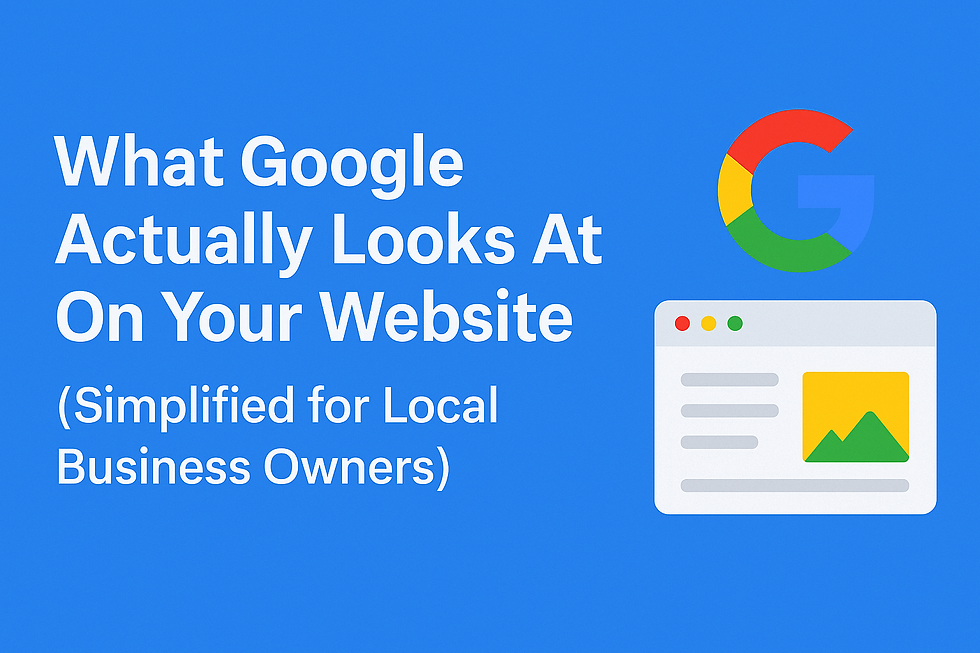How to Build a Dog Grooming Website That Brings in More Clients (Without Needing to Be a Tech Expert)
- Johnathon Crowder
- Aug 8
- 5 min read

Why This Matters More Than Ever
You can be the best groomer in town — the one who gets nervous dogs to relax, who knows how to hand-scissor a perfect doodle cut, who has regulars that drive across the county just for you.
But if your website doesn’t make a great first impression, many new clients will never make it through your door.
And here’s the truth: most dog grooming websites look okay to the owner, but don’t actually work to get bookings.
Why? Because they’re usually built by the groomer themselves (or a friend) using a quick DIY template.
The result:
Cute pictures… but no clear “Book Now” button
Long paragraphs… but no prices
Contact info buried at the bottom
Works on your laptop… but looks messy on a phone
This guide is going to fix that. And don’t worry — you don’t need to know “code” or spend weeks learning a new system. You just need to know what’s important and what to avoid.
Step 1: Start With Your Dream Client
Before you even open Wix, Squarespace, or WordPress, stop and think:
Do I want quick, budget-friendly appointments that turn over fast?
Do I want to specialize in certain breeds or fancy show cuts?
Do I want to be known for calming anxious dogs and taking my time?
Am I targeting busy professionals who want online booking, or retirees who will always call?
Why this matters:If your dream client is a busy working parent, your site needs to be super easy to book on a phone. If your dream client is a poodle show owner, your gallery should showcase precision scissoring and breed profiles.
“Gentle, breed-specific grooming with online booking — serving Springfield dog owners in under 7 days.”
That one sentence will guide your photos, your wording, and even your pricing page.
Step 2: Keep It Simple — But Effective
A lot of DIY groomer websites try to do too much: animated text, fancy backgrounds, or so many pages that clients get lost.
Your clients aren’t visiting your site for entertainment. They’re there for three things:
What you do (services)
What it costs (pricing)
How to book (contact or online booking)
That means your site can work beautifully with just these pages:
Home – quick intro, why you’re great, and a “Book Now” button.
Services & Pricing – simple list with “what’s included.”
Gallery – before/after photos of your actual work.
Reviews – happy clients with names, dog breeds, and quotes.
Contact/Booking – easy ways to call, text, or book online.
Everything else is optional.
Step 3: Make Sure It Works on Phones
Over 70% of people will check your site on their phone.
If it’s slow, hard to read, or makes them pinch-and-zoom, they’ll leave before booking.
Quick phone test:
Is your phone number at the very top? (And does tapping it open a call?)
Can you see prices without scrolling forever?
Is there a “Book Now” button right where you land?
Are photos the right size, or do they take forever to load?
If you find yourself frustrated on your own phone, your clients will be too.
Step 4: Show Real Photos (Not Stock Images)
Nothing builds trust faster than real work you’ve done.
Stock photos might look perfect, but pet owners can spot them a mile away — and they don’t help someone imagine their own dog in your hands.
Better approach:
Take before-and-after shots in the same spot so people can clearly see the transformation.
Use natural light when possible.
Keep the background uncluttered so the dog stands out.
Include yourself in a few photos smiling with the dog — it makes your business feel personal and trustworthy.
You don’t have to be a professional photographer. Clients aren’t expecting glossy magazine shots — they just want proof you can make dogs look and feel great.
Step 5: Be Clear About Pricing
One of the top reasons people leave a website is no prices listed.
Yes, every dog is different. But you can still give “starting at” prices for each service. This way, people know whether you fit their budget before they call.
Example:
Small Dog Full Groom – Starting at $55Bath, blow dry, brush out, haircut, nail trim, ear cleaning.
Large Dog Bath & Tidy – Starting at $75Bath, blow dry, brush out, paw and face trim, nail trim, ear cleaning.
This saves you time answering calls from people who expected $20 grooms.
Step 6: Make Booking Effortless
The harder it is to book with you, the fewer people will do it.
Your booking button should:
Be on every page (top and bottom)
Work perfectly on phones
Take people straight to a booking form (not just your email)
Tools like Square Appointments, Fresha, and Acuity are free or low-cost and make booking painless for both you and the client.
Step 7: Use Reviews Everywhere
Most people trust other pet owners more than anything you can say about yourself.
If you have good reviews on Google or Facebook, put them on your site:
On your homepage (under your intro)
On your booking page (next to the button)
On your reviews page (full list)
Pro Tip: Include the dog’s name in the review. It makes it feel real and relatable:
“My Goldendoodle, Bailey, has never looked better! She came home happy and smelling amazing.” – Sarah M.
Step 8: Tell People Where You Are (Everywhere)
You’d be surprised how many groomer sites never clearly say where they’re located until you dig for it.
Put your city and state:
In your homepage headline (Dog Grooming in Springfield, MO)
In your footer on every page
On your contact page (with a map if possible)
And make sure your Google Business Profile matches your website exactly — same name, address, and phone number.
Step 9: Keep It Fresh
A stale site makes people wonder if you’re still open.
Update it at least every few months:
Swap gallery photos
Add seasonal promos (holiday grooming, summer shave-downs)
Share grooming tips in a quick blog post or update section
Fresh content also helps you show up higher in Google.
Step 10: Know When to Call in Help
You can do this yourself. But most groomers are better off spending time grooming dogs, not fighting with website builders, resizing images, and learning SEO.
At Crowder Code & Design, we:
Build mobile-friendly websites that load fast
Add all the trust-builders clients look for (reviews, real photos, easy booking)
Make sure your site shows up when people search “dog groomer near me”
Keep it updated so you never have to touch it if you don’t want to
That means while you’re clipping nails and scissoring coats, your website is working in the background to bring you more appointments.
The Bottom Line
Your website isn’t just “something nice to have.” It’s your 24/7 salesperson.
A good dog grooming website:
Shows off your best work
Answers the questions clients have before they even ask
Makes booking a breeze
Builds trust before they ever meet you
And it doesn’t have to be complicated or expensive.
If you’d like a free custom video audit of your current site — showing exactly what’s helping and what’s costing you bookings — click here and I’ll send one straight to your inbox.
No pressure, no jargon, just clear tips you can use.




Comments